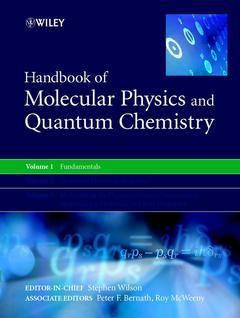Handbook of Molecular Physics and Quantum Chemistry, 3 Volume Set
Rédacteur en Chef : Wilson Stephen

The logical format of the Handbook allows the reader to progress from the foundations of the field to the most important and exciting areas of current research. Edited and written by an outstanding international team, and containing over 100 articles written by more than 50 contributors, it will be invaluable for both the expert researcher and the graduate student or postdoctoral worker active in any of the broad range of fields where these concepts and methods are important.
Comprises three themed volumes:
* Fundamentals
* Molecular Electronic Structure
* Molecules in the Physico-Chemical Environment: Spectroscopy, Dynamics and Bulk Properties
* Presents detailed articles covering the key topics, presented in a didactic manner
* Focuses both on theory and the relation of experiment to theory
Volume 1, Fundamentals presents the foundations of molecular physics and quantum chemistry. It consists of 7 parts arranged as follows:-
Part 1 Introduction
Part 2 Elements of Quantum Mechanics
Part 3 Orbital Models for Atomic, Molecular and Crystal Structure
Part 4 Symmetry Groups and Molecular Structure
Part 5 Second Quantization and Many-Body Methods
Part 6 Approximate Separation of Electronic and Nuclear Motion
Part 7 Quantum Electrodynamics of Atoms and Molecules
The central problem of molecular physics and quantum chemistry is the description of atomic and molecular electronic structure. The development of appropriate models for the description of the effects of electron
correlation and of relativity are key components of the analysis. Volume 2, Molecular Electronic Structure, addresses these topics, and consists of 7 parts arranged as follows:
Part 1 Approximation methods
Part 2 Orbital Models and Generalized Product Functions
Part 3 Electron correlation
Part 4 Relativistic molecular electronic structure
Part 5 Electronic structure of large molecules
Part 6 Computational quantum chemistry
Part 7 Visualization and interpretation of molecular electronic structure
In reality no molecular system exists in isolation. Molecules interact with other atoms and molecules, and with their environment. Volume 3, Molecules in the Physico-Chemical Environment - Spectroscopy, Dynamics and Bulk Properties, consists of 7 parts arranged as follows:-
Part 1 Response theory and propagator methods
Part 2 Interactions between molecules
Part 3 Molecules in different environments
Part 4 Molecular Electronic spectra
Part 5 Atomic Spectroscopy and Molecular Vibration-Rotation Spectroscopy
Part 6 Molecular dynamics and dynamical processes
Part 7 Bulk properties
Volume 1.
Introduction.
Elements of quantum mechanics.
Orbital models for atomic, molecular and crystal structure.
Symmetry groups and molecular structure.
Second quantization and many-body methods.
Approximate separation of electronic and nuclear motion.
Quantum electrodynamics of atoms and molecules.
Volume 2.
Approximation methods.
Orbital models and generalized product functions.
Electron correlation.
Relativistic molecular electronic structure.
Electronic structure of large molecules.
Computational quantum chemistry.
Visualization and interpretation of molecular electronic structure.
Volume 3.
Response theory and propagator methods.
Interactions between molecules.
Molecules in different environments.
Molecular electronic spectroscopy.
Atomic spectroscopy and molecular vibration-rotation spectroscopy.
Molecular dynamics and dynamical processes.
Bulk properties.
Stephen Wilson has published over 300 scientific papers and reviews, principally in theoretical and computational chemistry and molecular physics, but also in computing science and numerical analysis. He has authored two books - Electron Correlation in Molecules, Clarendon Press, Oxford, 1984, and Chemistry by Computer: An Overview of the Applications of Computers in Chemistry, Plenum Press, New York, 1986, and has edited some 21 volumes. He is an Editor-in-Chief of Progress in Theoretical Chemistry and Physics and Series Editor of Methods in Computational Chemistry. Dr. Wilson holds a D.Sc. from the University of Bristol.
Peter F. Bernath was born in Ottawa, Ontario, Canada and was educated at the University of Waterloo (B. Sc. in chemistry 1976) and Massachusetts Institute of Technology (Ph. D. in physical chemistry 1980). After a post-doctoral stint at the Herzberg Institute of Astrophysics of the National Research Council of Canada, he began his academic career at the University of Arizona in 1982. In 1991, he moved to the University of Waterloo as Professor of Chemistry and of Physics and now holds an Industrial Research Chair in Fourier Transform Spectroscopy. Prof. Bernath has interests in high resolution spectroscopy of molecules with applications in astronomy and atmospheric science. He is the author of the textbook Spectra of Atoms and Molecules.
Roy McWeeny's academic career spans five decades. After a first degree in Physics (Leeds University) and a D.Phil. from Oxford University (where he worked with C.A. Coulson), he was appointed Lecturer in Physical Chemistry, University of Durham. In the mid-1950s he was an invited member of J.C. Slater's famous Solid-State and Molecular Theory Group at MIT; and in 1960 spent a year as Associate Director of P.-O. Lowdin's Quantum Theory Group at Uppsala University. His other University appointments include a Lectureship in Mathematics, Physics
Date de parution : 03-2003
Ouvrage de 2200 p.
19.8x32.5 cm
Thème de Handbook of Molecular Physics and Quantum Chemistry, 3... :
Mots-clés :
elements; atomic; models; orbital; quantization; electronic; separation; approximate; electrodynamics; atoms; molecules; molecular; visualization; environments; different



